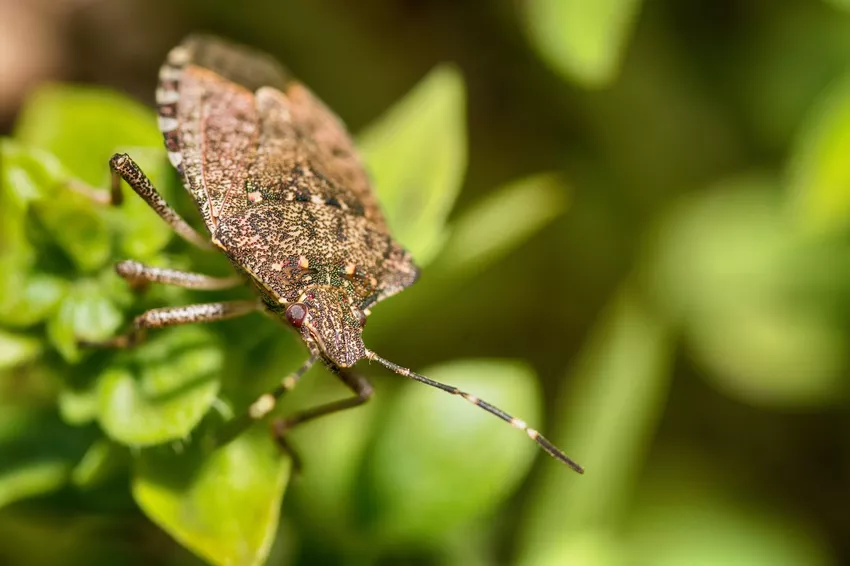Stink bugs also crawl into the house, especially when the temperature is falling. You can find out what you can and can do about it here, as well as more about the stink bug.

Especially after particularly warm and long summers, stink bugs (Petatomidae) can become a real nuisance. Then, when the temperatures slowly drop, the bugs look for a warm quarters for the winter months, which they often find in our apartments. We have compiled the following for you, what exactly characterizes stink bugs, whether they are dangerous and how best to combat them in the house.
Stink Bugs: A Wanted Poster
There are an estimated 40,000 different species of bugs worldwide (Heteroptera) and of these around 3,000 live here in Europe. The stink bugs are a subfamily of these bugs and actually look relatively clumsy. The bugs can be from 5mm to 35mm in size and have piercing and sucking mouthparts. They eat (or suck) their host plants, causing growth disorders and stunted growth. Unfortunately, the bugs can also transmit pathogens by sucking on the plants and thus damage the plants even more. Bugs are relatively easy to spot because of their triangular shape and their unpleasant habit of smelling bad, because the bugs can secrete a liquid that smells anything but pleasant. If you've ever crushed a bug with your finger, you probably know what we're talking about.
The bug that plagued many cities in the fall of 2022 is the marbled stink bug (Halyomorpha halys), which is native to Asia and was introduced to Europe. These marbled stink bugs are approximately 15mm in size and brownish-grey in colour. They have a black and white pattern on their sides and their antennae also have black and white stripes.

Life cycle of the stink bug
Bugs feed on plant saps, but there are also a few predatory species that feed on themtiny insects or arachnids. Some of the bugs that feed on plants with their stinging and sucking mouthparts can secrete a poisonous salivary juice that can lead to deformation and necrosis - i.e. the death of cells - in the plants.
The adult bedbugs become active again in spring at a temperature of over 10 °C and look for their own to recharge their batteries after the winter. The bug prefers rose plants (Rosales), trumpet trees (Catalpa), rowan berries (Sorbus aucuparia) or Ash trees (Fraxinus), but also summer lilac (Buddleja) are on their menu. After a few weeks of gorging on plant juices, the females begin to lay eggs. These eggs can be found on the leaves in groups of 20 to 30. A female can lay over 200 eggs in her lifetime. After a few days, the larvae hatch out of these and after the five larval stages they develop into adult stink bugs. This development from egg to adult takes up to two months. In the fall, the bugs look for a place to hibernate, and in the spring, this cycle starts all over again.

Are stink bugs dangerous or poisonous?
What many people have probably already noticed is the smell of the bugs, which takes some getting used to. But don't worry - the bugs only smell but are not dangerous. This smell becomes particularly noticeable when you try to get rid of the bugs with a fly swatter. This foul smell is formed in so-called stinky glands, which are located in the chest area. These bugs can also secrete contact poisons for defense, and they are also able to form alarm and aggregation pheromones. With these pheromones, the bugs can attract other conspecifics, but also alert them and keep them away if there is danger in a certain place. So that foul smell does have an advantage after all - it deters other bugs.
Stink bug: plant pest or not?
Bugs can be both harmful and useful. Their feeding and sucking on the plants can cause growth disorders and also crippling. Another harmful property of bugs is the transmission of pathogens - such as viruses, fungi or bacteria - to our cultures. By sucking on the plants, these pathogens can penetrate the plants and cause damage therecause, but there are also useful bugs.
Predatory bugs are even used as beneficial insects in greenhouses against pests such as spider mites (Tetranychidae), aphids (Aphidoidea) or psyllids ( Psylloidea) used. These bugs are not harmful to our plants, in fact they are beneficial to us. Such bugs can be encouraged by having natural spots in the garden and offering them opportunities to hibernate in hedges or trees.

Stink bug in the house and apartment: ways to combat it
When bugs invade our living spaces in large numbers, it can be quite annoying. Especially the mentioned unpleasant smell, which emanates from crushed bugs, can spoil one's appetite. The easiest way to ward off these animals is to prevent them from entering your living space, because the bugs like to look for warm winter quarters and thus find their way into our four walls. First of all, you can attach insect screens so that you can still air the room in peace. Not only do you keep annoying bugs away, you also keep other insects out of your living space. In addition, you should check if there are any other entry points for the bugs - such as cracks and crevices around the windows. Close them carefully.
If the bugs are already in your apartment, you can still attach sticky traps, which are otherwise used for flies, around the windows. The pests get stuck on these and you can easily remove them from the living rooms. The vacuum cleaner offers another method: simply suck in the bugs. That way you'll get rid of the bugs and not have to deal with the stench either.
You may not be dealing with stink bugs but with assassin bugs. Find out how to recognize and get rid of assassin bugs in our special article.